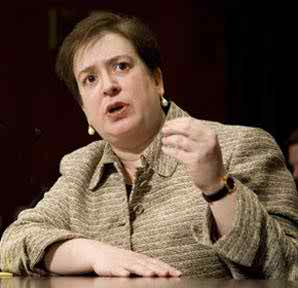Elena Kagan
(judge) | |
|---|---|
 | |
| Born | 1960-04-28 New York City, New York, U.S. |
| Alma mater | Hunter College, Princeton University, Worcester College (Oxford), Harvard Law School |
| Religion | Judaism |
| Party | Democratic |
Elena Kagan is an associate justice of the Supreme Court of the United States. She was nominated by President Barack Obama on May 10, 2010 and has served since August 7, 2010. Kagan is the fourth woman to become a member of the Court.
Kagan was born and raised in New York City. After graduating from Princeton University, the University of Oxford, and Harvard Law School, she clerked for a federal Court of Appeals judge and for Supreme Court Justice Thurgood Marshall.
Kagan also clerked for Chicago federal Appellate Judge Abner Mikva, who is one of Obama’s political mentors; She began her career as a professor at the University of Chicago Law School, where she became acquainted with the later president.
She left to serve as Associate White House Counsel, and later as a policy adviser under President Bill Clinton, who she helped in numerous legal cases.
Afterwards, she became a professor at Harvard Law School, where she hired legal scholar ('cognitive infiltration of conspiracy theorists') Cass Sunstein away from the University of Chicago.
In 2009, Kagan became the first female solicitor general of the United States. President Obama nominated her to the Supreme Court to fill the vacancy arising from the impending retirement of Justice John Paul Stevens.
Contents
Early career
In 1987, Kagan was a law clerk for Judge Abner J. Mikva of the United States Court of Appeals for the District of Columbia Circuit. She became one of Mikva's favorite clerks; he called her "the pick of the litter". In 1988, Kagan clerked for Justice Thurgood Marshall of the U.S. Supreme Court. Marshall said he hired Kagan to help him put the "spark" back into his opinions as the court had been undergoing a conservative shift since William Rehnquist became Chief Justice in 1986.
Kagan next entered private practice as a junior associate at the Washington, D.C., law firm of Williams & Connolly. As a junior associate, she drafted briefs and conducted discovery. During her short time at the firm, she handled five lawsuits that involved First Amendment or media law issues and libel issues.
In 1991, Kagan became an assistant professor at the University of Chicago Law School.[1] While there she first met Barack Obama, a guest lecturer at the school.[2][3] While on the UC faculty, Kagan published a law review article on the regulation of First Amendment hate speech in the wake of the Supreme Court's ruling in R.A.V. v. City of St. Paul; an article discussing the significance of governmental motive in regulating speech;[4] and a review of a book by Stephen L. Carter discussing the judicial confirmation process. In the first article, which became highly influential, Kagan argued that the Supreme Court should examine governmental motives when deciding First Amendment cases and analyzed historic draft-card burning and flag burning cases in light of free speech arguments.[5]
In 1993, Senator Joe Biden appointed Kagan as a special counsel for the Senate Judiciary Committee. During this time, she worked on Ruth Bader Ginsburg's Supreme Court confirmation hearings.[6]
Kagan became a tenured professor of law in 1995.[1] According to her colleagues, Kagan's students complimented and admired her from the beginning, and she was granted tenure "despite the reservations of some colleagues who thought she had not published enough".
White House and judicial nomination

Kagan served as Associate White House Counsel for Bill Clinton from 1995 to 1996, when Mikva served as White House Counsel. She worked on such issues affecting the Clinton administration as the Whitewater controversy, the White House travel office controversy, and sexual harassment (Paula Jones). From 1997 to 1999, she worked as Deputy Assistant to the President for Domestic Policy and Deputy Director of the Domestic Policy Council. Kagan worked on topics like budget appropriations, campaign finance reform, and social welfare issues. Her work is catalogued in the Clinton Library.[7]
Harvard Law School
After her service in the White House and her lapsed judicial nomination, Kagan returned to academia in 1999. She initially sought to return to the University of Chicago, but she had given up her tenured position during her extended stint in the Clinton Administration, and the school chose not to rehire her, reportedly due to doubts about her commitment to academia. Kagan quickly found a position as a visiting professor at Harvard Law School. In 2001, Kagan was named a full professor at Harvard Law School and in 2003 she was named dean of the Law School by Harvard University President Lawrence Summers.
As dean, Kagan inherited a $400 million capital campaign, "Setting the Standard," in 2003. It ended in 2008 with a record-breaking $476 million raised, 19% more than the original goal.[8] Kagan made a number of prominent new hires, increasing the size of the faculty considerably. Her coups included hiring legal scholar ('cognitive infiltration of conspiracy theorists') Cass Sunstein away from the University of Chicago[9][10] She also made an effort to hire conservative scholars, such as former Bush administration official Jack Goldsmith.
Supreme Court
She is considered part of the Court's liberal wing but tends to be one of the more moderate justices of that group. She wrote the majority opinion in Cooper v. Harris, a landmark case restricting the permissible uses of race in drawing congressional districts.
References
- ↑ a b https://web.archive.org/web/20100511220447/http://blogs.suntimes.com/sweet/2010/05/elena_kagan_at_bat_played_chic.html%7C
- ↑ https://web.archive.org/web/20181201135146/http://archive.boston.com/news/nation/washington/articles/2010/05/16/personal_ties_bind_obama_kagan/?page=1
- ↑ https://web.archive.org/web/20181202155030/https://www.nbcchicago.com/news/local/Kagan-and-Obama-Go-Way-Back-93267019.html
- ↑ https://web.archive.org/web/20181217110652/https://chicagounbound.uchicago.edu/uclrev/vol63/iss2/2/
- ↑ https://web.archive.org/web/20160823184526/http://www.scotusblog.com/wp-content/uploads/2010/03/Private-Speech-Public-Purpose.pdf}
- ↑ https://web.archive.org/web/20180404202722/https://www.cnn.com/2013/02/19/us/elena-kagan-fast-facts/index.html
- ↑ https://web.archive.org/web/20141219141510/http://www.clintonlibrary.gov/kagan.html
- ↑ https://web.archive.org/web/20090119043152/http://www.law.harvard.edu/news/2008/10/23_campaign.html
- ↑ https://web.archive.org/web/20100705122520/http://www.boston.com/news/education/higher/articles/2009/01/04/shes_thawed_harvard_law/
- ↑ https://web.archive.org/web/20120118125500/http://www.hlrecord.org/2.4463/lessig-rejoining-faculty-1.577371